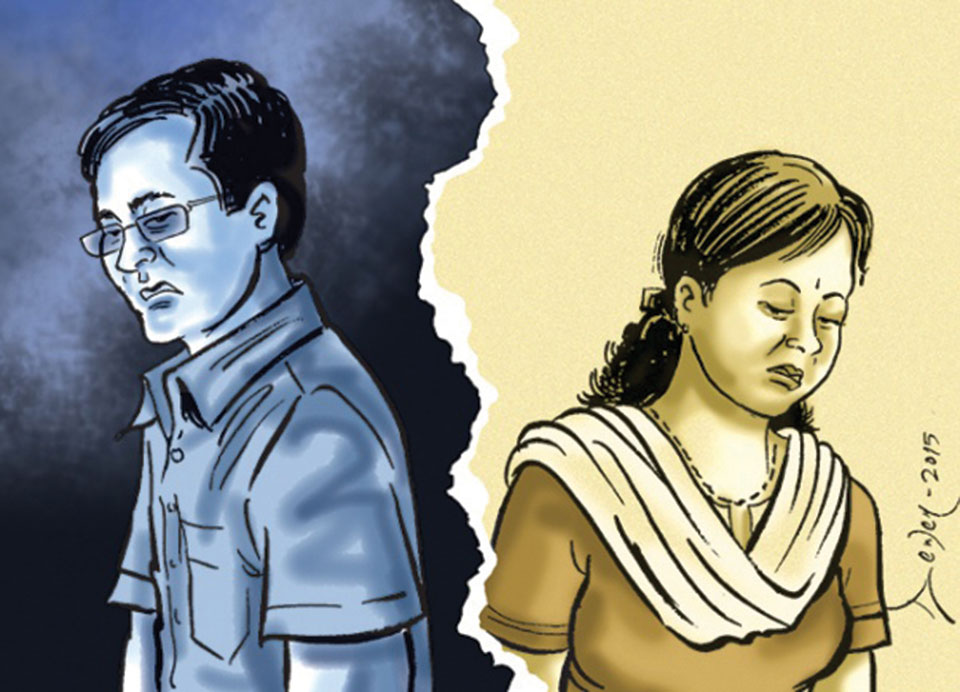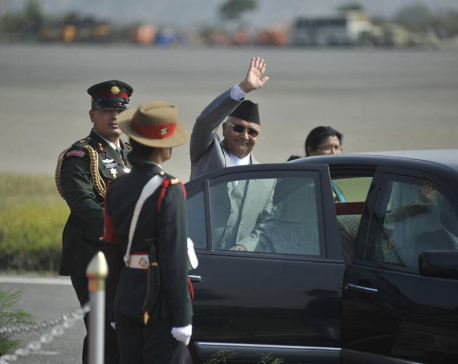
OR
Opinion

More from Author
Divorce does not sound good because it means split, separate, and disunite. In its legal definition, it is the legal termination of the marital journey of a couple. In some cases, it may be desirable, but in most cases, it is tragic, and that disorganizes the family. However, divorce is part of all societies and has become more common in modern society. Some theoretical aspects of divorce and some ups and downs of divorce in the family and community are assessed in the article. The objective of this assessment is not to favor or oppose the idea of divorce. It considers some data on divorce and observes the sociology of divorce in Nepal.
Divorce in Modern Nepal
The enactment of "The National Civil (Code) Act, 2017 (2074)" has established explicit provisions relating to divorce. The Civil Act's part three (Family Law) articles 93, 94, and 95 have precise provisions for divorce. More specifically, Article 94 explains the circumstances in which the husband may appeal for divorce, and Article 95 describes the conditions under which the wife may request for divorce. The good thing about this Civil Act is that it opened the door for both husband and wife to initiate divorce if they decide to split. Since the enactment of this code, divorce cases in Nepal have been mounting every year. According to the annual report of vital registration published by the Ministry of Federal Affairs and Local Development in 2015, there were only 1,355 divorce cases in Nepal. The number of cases increased to 6,644 in 2020, per the yearly report published by the Department of National ID and Civil Registration. Today, as per the official website (accessed on Aug 5, 2023) of the Department of National ID and Civil Registration, 50,111 divorce cases are registered online. These data show that cases of divorce in Nepal are mounting. What are the theoretical perspectives on divorce? Why divorce is common? What are the upsides and downsides of divorce? And is divorce good or bad? These questions need some assessment to understand the sociology of divorce.
What are the theoretical perspectives on divorce?
For many functionalists, family problems arise from sudden or far-reaching family structure and pattern changes. Changes in critical functions of a family, for example, economic condition, recreation and amenities, care and love, sex and reproduction, etc, cause a difference in the family structure and patterns and may end up in divorce. Many interactionists believe that the differences in understanding and expectations that spouses have of their marriages result in divorce. It means that spouses have different experiences from their mates than what they expect from their wedding. For example, the breadwinner's changing role, ideas about childbearing, unrealistic expectations from a mate, etc, may bring misunderstandings between the couple. Conflict theorists, especially feminists, believe in male domination, i.e., in patriarchy, wives are used as reproductive labor or means of amusement. According to them, patriarchal practices rooted in society cause power imbalances in marital lives, females feel more oppressed, and married life becomes less happy. According to the feminists, domination, discrimination, and violence against females cause divorce.
Why divorce is common now?
In the past, once people divorced, they were considered social outcasts and suspected as immoral in society. Therefore, people used to compromise and stay together, but today, the scenario has changed. A tiny misunderstanding may result in separation. Mainly, four causes make divorce common in Nepal.
First is foreign employment. Today, many Nepalese youth, primarily male and partially female after marriage, go for foreign jobs to carry the increasing family responsibilities. According to data from the Centre for the Study of Labor and Mobility, about 500,000 youth in Nepal enter the labor market each year, and 400,000 go for foreign employment. Separation of mates for a long time may wither the care, love, and trust in each other.
Second, economic independence. The definition of breadwinner and homemaker has been changed. Traditionally, males used to be the breadwinners and female homemakers, but this definition has changed in almost all societies, along with increasing economic independence among women. One report published by the International Water Association (2021) reveals that the share of women in wage employment in the non-agriculture sector in Nepal reached 44.8 percent in 2013 from only 18.9 percent in 1990.
Third, easy access to social and mass media and the massive attraction of people towards these media platforms. According to one report by the Nepal Telecommunication Authority, about 91 percent of the population now have access to the internet, and more than 41.0 percent of the country's population is active on social media, according to Datareportal (2023). People are more aware of their rights, violence, and global trends. Women started to speak about violence, both domestic and sexual, on many of these online platforms, for example, the "Me Too" movement earlier and "TikTok" today. Also, the use of social media eases infidelity for both men and women. Various online apps and media platforms make interaction and dating possible. This may hurt relationships. Studying how social media has impacted divorce in Nepal is exciting and could be a good topic.
Fourth, changing legislation and culture. For example, the Civil Act 2017's provisions relating to divorce have made it easier to demand divorce for both mates, and the societal understanding of divorce has changed compared to some decades ago. The enactment of different civil rights and public movements has also widened the people's concept of individual freedom and liberty. Education and changes in culture have changed the way of life today than it used to in the last century.
What are the ups and downsides of divorce?
This is a very controversial topic to debate over because demarking ups and downsides are mostly relative perceptions. However, in general, divorce may give people more individual freedom, ensure a sigh of relief physically and mentally, and even provide a healthier household environment. But divorce entails many downsides, for example, increased economic burden, impacts on childcare and children's mental health, difficulties in sickness and aging, social outcasts, and threats to the family's stability. Then, is divorce good or bad? It has no objective answer. It is a toss-a-coin issue. It depends upon the value judgment and the person's case specific. Neither theory nor personal experiences can objectively answer whether it is good or not.
Conclusion
Is divorce desired or compulsion? Is it a sign of personal fulfillment or a reason to shame? What are the consequences of divorce in Nepalese society? Does legislation such as the National Civil Act 2017 promote divorce? What would be the social trend of divorce in the nation in the next ten years? These and similar questions are debatable when talking about the issue of divorce. However, Nepal's divorce data trend is compelling and more serious. Its trend indicates that divorce is emerging as a new social problem in Nepal. Whatever the opinion on divorce, the reality is that it disorganizes the family and impacts the wellness of society. Therefore, the debate on the causes and consequences of divorce and remedies to check divorce from the community to the policy level is crucial.
You May Like This

NOC slashes price of petrol by Rs 7 per liter, diesel and kerosene by Rs 5 per liter
KATHMANDU, May 15: Nepal Oil Corporation (NOC) has announced a significant reduction in the prices of petrol, diesel and kerosene. Read More...

Federalism: learning by doing
Issues have emerged regarding effective implementation of federalism. But there is a long way to go and these issues can... Read More...

What Nepal needs is India's friendship and support for growth: Nepal PM Oli
In an exclusive interview to The Hindu, Mr. Oli says the bitterness of past relations have been put behind them,... Read More...







Just In
- NRB to provide collateral-free loans to foreign employment seekers
- NEB to publish Grade 12 results next week
- Body handover begins; Relatives remain dissatisfied with insurance, compensation amount
- NC defers its plan to join Koshi govt
- NRB to review microfinance loan interest rate
- 134 dead in floods and landslides since onset of monsoon this year
- Mahakali Irrigation Project sees only 22 percent physical progress in 18 years
- Singapore now holds world's most powerful passport; Nepal stays at 98th












Leave A Comment